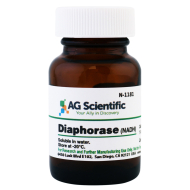Diaphorase enzymes are a class of dehydrogenase enzymes that catalyze reactions involving the nicotinamide adenine dinucleotide cofactors. Two specific members of this enzyme class, denoted as NADH diaphorase and NADPH diaphorase, are responsible for dehydrogenating the reduced forms of NAD and NADP, respectively. These enzymes, which occur naturally in all animal tissues, were first extracted in pure form by Straub in 1939.
Mechanism of Action
Within the nicotinamide adenine dinucleotide family of compounds, two members (NAD and NADP) act as hydride acceptors, while their respective reduced forms (NADH and NADPH) act as hydride donors. The role of the diaphorase enzymes is to transfer hydrogen ions between donor and acceptor molecules. The dehydrogenation of the reduced form NADPH, for example, requires the target molecule itself, an H+ ion and an acceptor molecule. The result of this reaction is therefore one NADP molecule and a reduced acceptor.
Role of Diaphorase Enzymes in Living Tissues

Through the mechanism of transferring electrons between reduced and oxidized forms of NAD, the diaphorase enzymes support a number of critical processes in living tissues. One such process is the ongoing conversion of methemoglobin into ordinary hemoglobin. In this process, NADH diaphorase works in conjunction with cytochrome b5 reductase to oxidize NADH and reduce methemoglobin, thus producing hemoglobin. Deficiencies of NADH diaphorase and cytochrome b5 reductase in leukocytes and platelet cells are therefore associated with hereditary methemoglobinemia.

NADPH diaphorase is also known to play a role in specific types of neurons. Non-pyramidal neurons with high concentrations of NADPH diaphorase synthesize nitric oxide, a compound that is essential to various aspects of brain and nervous system function. Specifically, nitric oxide is known to cause the release of certain neurotransmitters and neuroactive amino acids. NO has also been shown to support the expression of proteins linked to neuroplasticity.
Current Areas of Research
Owing to their close association with the cofactor NAD, diaphorase enzymes have played an important role in recent research into this compound's role in the aging process. Recent research has shown that NAD levels decrease with age, resulting in reduced expression of sirtuin proteins and mitochondrial function, among other downstream effects. In several studies relating to the role of NAD in mitochondrial aging, diaphorase enzymes have been used as a component of cycling assay mixtures.
Other research has dealt with the role of NADPH dehydrogenase quinone 1, otherwise known as DT-diaphorase or DTD, in certain types of cancer. In several varieties of tumorous cells, DTD levels increase beyond their normal levels in non-tumorous tissues. As a result, DTD has been studied as a potential target for new classes of chemotherapeutic agents. Though potentially effective, research into DTD as a chemotherapeutic target requires the development of drugs other than the widely used Mitomycin C, which requires specific pH conditions in order to be metabolized.
Diaphorase Enzymes from AG Scientific
| SKU | Product | CAS |
| N-1181 | Diaphorase (NADH) | 9032-20-6 |
| N-1185 | Diaphorase (NADPH) | 9001-68-7 |

